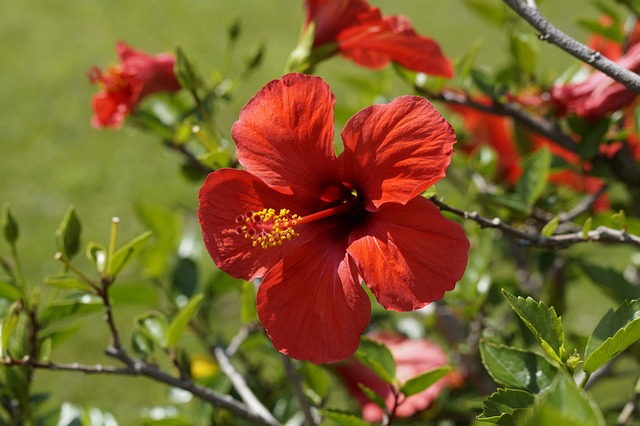Hibiscus plants are beloved for their stunning, vibrant flowers that come in a variety of colors and sizes. These tropical beauties are a common sight in gardens and landscapes during the warm months, but what happens to them when winter rolls around? Can hibiscus survive winter? In this guide, we will explore the various aspects of hibiscus winter care and provide you with essential tips to ensure your hibiscus plants make it through the cold season with flying colors.
Understanding Hibiscus Varieties
Before delving into hibiscus winter survival strategies, it’s crucial to understand that not all hibiscus varieties are created equal. There are two primary types of hibiscus that you may encounter: hardy hibiscus and tropical hibiscus.
- Hardy Hibiscus (Hibiscus moscheutos)
- Also known as rose mallow or swamp mallow.
- Native to North America.
- Grows well in USDA hardiness zones 4-9.
- Can withstand cold winters and even thrive in colder climates.
- Tropical Hibiscus (Hibiscus rosa-sinensis)
- Commonly referred to as Chinese hibiscus or Hawaiian hibiscus.
- Native to warm, tropical regions.
- Typically grown as a potted plant or in warm climates (USDA zones 9-11).
- Susceptible to cold and frost damage.
Now that you know the difference between hardy and tropical hibiscus, let’s explore the key factors to consider for each when it comes to surviving winter.
Hardy Hibiscus: Surviving Cold Winters
Hardy hibiscus varieties are more resilient to cold weather, making them an excellent choice for gardeners in regions with harsh winters. Here’s how you can ensure the survival and vitality of your hardy hibiscus during the winter months.
- Pruning:
- Prune your hardy hibiscus in late winter or early spring before new growth begins. Trim back any dead or damaged branches to encourage healthy new growth.
- You can also cut the plant down to a few inches above the ground in late winter. This rejuvenation pruning helps the plant produce vigorous new shoots in the spring.
- Mulching:
- Apply a thick layer of mulch around the base of your hardy hibiscus to insulate the roots and protect them from freezing temperatures.
- Organic mulch, such as shredded leaves or straw, works well to retain moisture and regulate soil temperature.
- Winter Protection:
- In areas with extremely cold temperatures, consider covering your hardy hibiscus with burlap or a frost cloth during the harshest winter nights.
- Make sure to remove the coverings during the day to allow sunlight and air circulation.
- Soil Preparation:
- Ensure that your hardy hibiscus is planted in well-draining soil. Proper drainage prevents waterlogged roots, which can lead to root rot during winter.
- Avoid fertilizing your hibiscus in late summer or early fall to discourage new growth that may not have time to harden off before winter.
- Location Matters:
- Plant your hardy hibiscus in a location where it can receive ample sunlight during the growing season. Full sun is essential for robust growth.
- Consider planting near a south-facing wall or other heat-retaining structure, which can provide some extra warmth during colder nights.
- Winter Watering:
- Water your hardy hibiscus sparingly during the winter months. The plant’s water requirements are significantly reduced in cold weather.
- Be cautious not to overwater, as this can lead to root problems in cold, wet soil.
Tropical Hibiscus: Protecting Them from the Cold
Tropical hibiscus varieties are more delicate and less cold-tolerant than their hardy counterparts. If you live in an area with mild winters or plan to overwinter your tropical hibiscus indoors, here are some essential steps to ensure their survival:
- Indoor Overwintering:
- Tropical hibiscus can be brought indoors during the winter months to protect them from freezing temperatures. Before bringing them inside, inspect the plants for pests and diseases, and treat if necessary.
- Place your potted hibiscus near a sunny window where they can receive at least 6 hours of bright, indirect sunlight per day.
- Maintain indoor temperatures between 55°F and 65°F (13°C to 18°C) to mimic their preferred tropical climate.
- Pruning and Maintenance:
- Before moving your hibiscus indoors, prune it lightly to remove dead or leggy growth. This will encourage bushier growth during the winter.
- Reduce watering frequency during the indoor months, allowing the top inch of soil to dry out before watering.
- Pest Control:
- Keep an eye out for common indoor plant pests like aphids, mealybugs, and spider mites. Treat any infestations promptly with organic insecticidal soap or neem oil.
- Humidity:
- Tropical hibiscus thrive in high humidity. To mimic their natural environment, consider using a humidity tray or a room humidifier to maintain adequate moisture levels.
- Outdoor Protection:
- If you prefer to leave your tropical hibiscus outdoors during mild winters, monitor the weather closely and be prepared to protect them when frost is expected.
- Cover the plants with frost cloths or blankets overnight, ensuring that the covers do not touch the foliage.
- Prudent Watering:
- Continue to water your outdoor tropical hibiscus sparingly during the winter, adjusting the frequency based on local weather conditions.
- Avoid watering during freezing temperatures to prevent root damage.
Overwintering tropical hibiscus indoors can be a successful strategy, but it requires careful attention to their specific needs. With the right care, you can enjoy the lush beauty of your tropical hibiscus year-round.
Common Winter Hibiscus Problems and Solutions
No matter which type of hibiscus you’re growing, there are common problems that can arise during the winter months. Here are some issues you may encounter and how to address them:
- Yellowing Leaves:
- Yellowing leaves can be a sign of overwatering, which is common during winter when the plant’s water requirements are lower. Ensure the soil is allowed to dry out slightly between waterings.
- Drop in Blooms:
- Hibiscus plants often reduce their blooming during the winter as a natural response to lower light levels. This is normal, and blooming should resume in the spring when sunlight increases.
- Pests and Diseases:
- Keep a close watch for pests and diseases, particularly if you’re overwintering tropical hibiscus indoors. Inspect the leaves and stems regularly for any signs of trouble and treat promptly.
- Weak Growth:
- Weak growth during the winter months is expected for tropical hibiscus when they receive less sunlight. Ensure your indoor plants get enough light and consider using a grow light if necessary.
- Fertilization:
- Avoid fertilizing hibiscus plants during the winter. Fertilizer can encourage new growth when the plant should be conserving energy for the colder months.
Spring Revival: Preparing for a Gorgeous Blooming Season
As winter fades and spring approaches, it’s time to prepare your hibiscus plants for their blooming season. Whether you have hardy or tropical varieties, these steps will help ensure a vibrant and healthy display of flowers:
- Pruning and Trimming:
- As soon as the risk of frost has passed in early spring, prune your hibiscus plants. Remove any remaining dead or damaged branches and trim the plant to shape.
- For tropical hibiscus that have been overwintered indoors, consider repotting them in fresh, well-draining soil to encourage healthy growth.
- Fertilization:
- In early spring, begin fertilizing your hibiscus with a balanced, slow-release fertilizer. Follow the package instructions for the proper application rate.
- Use a fertilizer with a higher phosphorus content (the middle number on the fertilizer label) to promote flowering.
- Sunlight Exposure:
- Ensure your hibiscus plants receive full sun during the growing season. Place them in a location where they can bask in sunlight for at least 6 hours a day.
- Watering Routine:
- Adjust your watering schedule to the needs of your hibiscus as they wake up from their winter dormancy. Water deeply and consistently, allowing the top inch of soil to dry out between waterings.
- Pest Prevention:
- Continue to monitor for pests and diseases, especially during the spring when new growth is most vulnerable. Regularly inspect your plants and take action if necessary.
Conclusion
The question of whether hibiscus can survive winter ultimately depends on the variety you’re growing and the care you provide during the cold season. Hardy hibiscus is well-equipped to withstand winter conditions, while tropical hibiscus may require special attention and protection.
By following the guidelines outlined in this article, you can ensure that your hibiscus plants not only survive winter but thrive and reward you with their breathtaking blooms when spring arrives. With a little knowledge and care, you can enjoy the beauty of hibiscus in your garden or as indoor plants year-round, regardless of the weather outside. Happy gardening!










